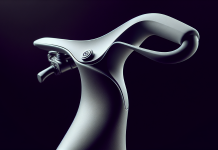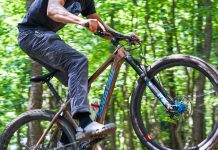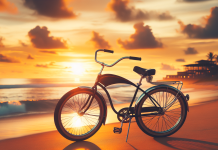Get ready to embark on an exhilarating adventure with our fat bikes! These innovative bicycles are equipped with wide tires that are specifically designed for unmatched traction on sandy beaches and snowy terrains. Whether you’re seeking a thrilling ride along the beach or a winter wonderland excursion, our fat bikes will provide you with the ultimate experience of exploring these diverse landscapes. So, grab your helmet, tighten those shoelaces, and join us on this thrilling journey with our impressive fat bikes.
Table of Contents
What are Fat Bikes?
Definition
Fat bikes are a type of bicycle that feature wide, oversized tires designed to provide optimal traction and stability while riding on challenging terrains such as sand and snow. These bikes typically have tire widths ranging from 3.8 to 5 inches, which is significantly wider than the tires on traditional mountain bikes. The wide tires allow fat bikes to comfortably glide through soft, loose surfaces, making them suitable for off-road adventures in various conditions.
Origin
Fat bikes were originally developed in Alaska in the 1980s as a means of transportation for riders in snowy and icy conditions. It was in this environment that the need for a bicycle that could effectively navigate through the deep snow and slippery surfaces arose. Fat bikes quickly gained popularity among outdoor enthusiasts and bike enthusiasts alike, and their usage has since expanded to include sandy beaches, muddy trails, and a variety of other challenging terrains.
Design Features
One of the most distinctive design features of fat bikes is their wide tires. These wide tires allow fat bikes to effectively distribute the rider’s weight over a larger surface area, providing better stability and preventing sinking into soft surfaces. Additionally, the tires on fat bikes are typically run at lower air pressure, further enhancing traction and flotation. The frames of fat bikes are also typically reinforced and built to withstand the rigors of riding in demanding environments. Moreover, fat bikes often feature wider handlebars and shorter stems to provide riders with better control and maneuverability.
Advantages of Fat Bikes
Riding on Sand
Fat bikes excel in riding on sand due to their wide tires and lower tire pressure. The increased tire surface area allows fat bikes to stay afloat on loose sand, providing a smoother and more enjoyable riding experience. Furthermore, fat bikes’ wider tires help to prevent sinking into the sand, giving riders a greater sense of control and stability. Whether cruising along the shoreline or exploring desert trails, fat bikes are the perfect companion for sand riding adventures.
Riding on Snow
One of the key advantages of fat bikes is their ability to conquer snowy terrain. The wide tires of fat bikes provide excellent flotation on deep snow, allowing riders to effortlessly glide through the white powder. The larger contact patch created by the wide tires enhances traction, creating a stable and predictable ride even in slippery conditions. Whether you’re exploring snowy trails, commuting during the winter months, or seeking new thrills on the slopes, fat bikes are the ideal choice for snow riding.
Versatility
One of the major advantages of fat bikes is their versatility. These bikes can tackle a wide range of terrains, including sand, snow, mud, and rocky trails. Unlike specialized bikes for specific terrains, fat bikes can adapt to changing conditions, making them suitable for a variety of outdoor adventures. Whether you’re a beach cruiser, a trail conqueror, or an off-road explorer, a fat bike will open up new possibilities and allow you to enjoy areas previously inaccessible with traditional bikes.
Comfort
Fat bikes offer a comfortable and enjoyable riding experience, thanks to their wide tires that act as natural suspension. The wide tires absorb bumps and shocks from the terrain, providing a smoother ride and reducing fatigue on long rides. The low tire pressure also increases comfort by allowing the tires to mold and conform to uneven surfaces, further enhancing the cushioning effect. With a fat bike, you can say goodbye to discomfort and enjoy hours of riding in utmost comfort.
Increased Traction
The wide tires of fat bikes provide exceptional traction on all terrains. Whether it’s loose gravel, wet rocks, or slippery mud, these bikes offer superior grip and control, minimizing the risk of skidding and sliding. The larger contact patch of the wide tires spreads the weight of the rider more evenly, allowing for better traction and stability. Whether you’re climbing steep hills or descending challenging slopes, fat bikes ensure you have the traction you need to conquer any terrain.
Durable and Sturdy
Fat bikes are built to withstand the rigors of off-road riding. Their frames are generally constructed from durable materials such as aluminum or carbon fiber, ensuring strength and longevity even in rough conditions. The wide tires are designed to be puncture-resistant, reducing the risk of flats while riding on rocky or sharp terrains. Fat bikes are engineered to be tough and reliable, allowing riders to push their boundaries and explore with confidence.
Choosing the Right Fat Bike
Tire Width
When choosing a fat bike, one of the key factors to consider is the tire width. Fat bikes typically have tire widths ranging from 3.8 to 5 inches. Wider tires offer increased flotation on soft surfaces such as sand and snow, providing better traction and stability. However, it’s essential to strike a balance between tire width and the bike’s overall performance. Wider tires may increase rolling resistance and require more effort to pedal, so it’s important to choose a tire width that suits your specific riding needs.
Tire Pressure
Another important consideration is tire pressure. Fat bikes’ tires are typically run at lower air pressure compared to traditional bikes. Lowering the tire pressure allows for better traction and increases the tire’s surface contact area. However, it’s crucial to find the right balance to avoid pinch flats and reduce the risk of damaging the rims. Experimenting with tire pressure and finding the sweet spot that provides optimal grip and performance is key to getting the most out of your fat bike.
Frame Material
The frame material plays a significant role in the overall weight and durability of the fat bike. Aluminum frames are commonly used in fat bikes due to their lightweight nature and excellent strength-to-weight ratio. Carbon fiber frames offer even greater weight savings and increased stiffness, providing a snappy and responsive ride. However, carbon fiber frames can be more expensive than aluminum frames. Consider your budget, riding style, and preferences when deciding on the frame material for your fat bike.
Suspension
Fat bikes are available with either rigid forks or front suspension forks. Rigid forks are typically lighter and offer better power transfer, making them ideal for riders who prioritize speed and efficiency. On the other hand, front suspension forks absorb bumps and shocks from rough terrains, enhancing comfort and control. If you plan on tackling more technical trails or prioritize a smoother ride, a fat bike with front suspension may be the better choice.
Gearing System
The gearing system of your fat bike will greatly impact its performance in various terrains. For riders who plan on tackling challenging hills or technical terrain, a wide gear range with lower gears will be beneficial. This will allow for easier climbing and better control on descents. Consider the terrain you’ll be riding on and choose a gearing system that provides the right balance of speed and power for your riding needs.
Brakes
Reliable brakes are essential for fat bike riding, especially when navigating through challenging terrains. Many fat bikes are equipped with disc brakes, which offer consistent and reliable braking performance even in wet or muddy conditions. Mechanical disc brakes are easier to maintain and repair, while hydraulic disc brakes typically provide better modulation and stopping power. Choose a brake system that suits your riding style and provides the necessary stopping power for your fat bike adventures.
Riding Techniques for Sand and Snow
Lower Tire Pressure
When riding on sand or snow, lowering your fat bike’s tire pressure is essential for optimal performance. Lower tire pressure increases the surface contact area of the tires, allowing them to float on top of the sand or snow instead of sinking in. This provides better traction and stability, making it easier to navigate through soft surfaces. Experiment with different tire pressures to find the sweet spot that provides the best riding experience for the specific conditions.
Maintaining Momentum
Keeping a steady forward momentum is crucial when riding on sand or snow. Avoid sudden stops or slowing down too much, as this can cause your fat bike to sink into the soft surface. Instead, maintain a consistent pace and focus on smooth pedal strokes to keep the bike moving. Maintaining momentum will help you glide through sand or snow with ease and reduce the effort required to ride in challenging conditions.
Avoiding Sharp Turns
When riding on sand or snow, it’s important to avoid sharp turns, especially at high speeds. The soft surface can cause the tires to dig in or slide out, potentially leading to a loss of control. Instead, take wider turns and gradually ease into the corners to maintain traction and stability. As with any type of off-road riding, it’s important to anticipate and plan your turns in advance to ensure a safe and enjoyable ride.
Balancing Weight Distribution
Proper weight distribution is key when riding on sand or snow. Shift your weight slightly backward to prevent the front wheel from digging in and losing traction. This helps to keep the bike balanced and allows the tires to evenly distribute the weight over the surface. Experiment with your weight distribution to find the optimal balance that provides the best control and stability while riding on challenging terrains.
Using Proper Gearing
Selecting the appropriate gear when riding on sand or snow is crucial for maintaining traction and control. Lower gears are generally preferred, as they provide more torque and make it easier to pedal through soft surfaces. Use a gear that allows you to maintain a steady cadence without straining too much. By choosing the right gear and maintaining a consistent pedal stroke, you can smoothly navigate through sand or snow and conquer challenging terrains with ease.
Maintaining and Cleaning Fat Bikes
Cleaning Sand and Snow
After riding on sandy or snowy terrains, it’s important to clean your fat bike to maintain its performance and prolong its lifespan. Start by removing any excess sand or snow with a soft brush or cloth. Pay attention to the drivetrain and components, as sand and snow can accumulate and cause premature wear. Use a gentle detergent and warm water to clean the frame, tires, and components. Rinse thoroughly and dry the bike to prevent any rust or corrosion.
Inspecting Tires and Wheels
Regularly inspecting your fat bike’s tires and wheels is essential for safety and optimal performance. Check for any signs of wear, cracks, or punctures in the tires. Ensure the tire pressure is within the recommended range. Inspect the wheels for any loose spokes or damage. Pay attention to the rims for any dents or sharp edges that could affect tire seating. Regular inspections and maintenance will help identify and address any issues before they become more severe.
Lubrication
Proper lubrication is essential for smooth and efficient fat bike performance. Apply lubricant to the chain, derailleur, and other moving parts to reduce friction and prevent premature wear. Use a bike-specific lubricant suitable for the conditions you’ll be riding in. For sand or snow riding, consider using a dry lubricant that repels dirt and prevents build-up. Regularly clean and reapply lubricant to keep your fat bike running smoothly and protect it from the elements.
Adjusting Gears
Regularly adjusting the gears of your fat bike is crucial for maintaining smooth shifting and optimal performance. If you notice any issues with shifting, such as hesitation or chain skipping, it may be necessary to fine-tune the gear adjustments. Familiarize yourself with the gear adjustment process, or take your fat bike to a professional bike shop for assistance. Properly adjusted gears will ensure an enjoyable riding experience and minimize the risk of component damage.
Regular Check-ups
In addition to regular cleaning and maintenance, it’s important to schedule regular check-ups for your fat bike. Take your bike to a professional bike shop for a thorough inspection and tune-up at least once a year. This will allow trained technicians to identify any potential issues and perform necessary adjustments or repairs. Regular check-ups will help extend the lifespan of your fat bike and ensure it remains in optimal condition for many rides to come.
Safety Tips for Fat Bike Riding
Wearing Protective Gear
When riding a fat bike, it’s important to prioritize safety. Always wear a helmet to protect your head in case of accidents or falls. Additionally, consider wearing knee and elbow pads for extra protection. Eye protection, such as sunglasses or goggles, is also recommended to shield your eyes from dust, debris, and UV rays. Remember to wear appropriate clothing to protect yourself from the elements and ensure maximum comfort during your fat bike adventures.
Choosing Suitable Trails
Selecting suitable trails for fat bike riding is crucial for both safety and enjoyment. Always choose trails that are suitable for your skill level and the capabilities of your fat bike. Consider the terrain, difficulty level, and technical features of the trail. Research and gather information from local sources, such as bike shops or online forums, to ensure you choose trails that align with your fat bike riding goals. Riding on designated trails not only ensures your safety but also helps in preserving the natural environment.
Checking Weather Conditions
Before embarking on a fat bike ride, it’s important to check the weather conditions. Be aware of any potential hazards or extreme weather conditions that could impact your ride. Strong winds, heavy rain, or extreme temperatures may affect your safety and comfort. Plan your ride accordingly, take necessary precautions, and be prepared for changing weather conditions. Knowing the weather forecast will allow you to adjust your ride plans and destination for a safer and more enjoyable experience.
Maintaining Visibility
Visibility is essential when riding a fat bike, especially in low-light or low-visibility conditions. Equip your fat bike with front and rear lights to ensure you are visible to others on the trail. Choose lights with different brightness options to adapt to various lighting conditions. Reflective clothing, tape, or accessories can also enhance your visibility, making it easier for others to see you. Prioritizing visibility increases your safety and reduces the risk of accidents while riding in different environments.
Hydration and Nutrition
Proper hydration and nutrition are essential for maintaining energy and stamina during fat bike rides. Carry a sufficient amount of water or electrolyte drinks to stay hydrated throughout your ride. Remember to pack nutritious snacks or energy bars to fuel your body during longer rides. Regularly replenishing fluids and consuming appropriate nutrition will help prevent fatigue and improve endurance, ensuring you can fully enjoy your fat bike adventures.
Riding in Groups
Riding in groups can enhance safety and enjoyment when exploring new trails or venturing into challenging terrains. Riding with others allows for increased visibility and mutual support in case of accidents or emergencies. It also provides an opportunity to learn from experienced riders and share tips and techniques. Riding in groups fosters a sense of camaraderie and adds an element of fun to your fat bike rides. However, it’s important to respect trail etiquette and be considerate of other riders and trail users when riding in a group.
Popular Fat Bike Models
Salsa Beargrease
The Salsa Beargrease is a popular fat bike known for its lightweight and performance-oriented design. It features a carbon frame for reduced weight and increased stiffness. The Beargrease is equipped with high-quality components and offers exceptional traction and control on various terrains. Whether you’re racing or embarking on long-distance off-road adventures, the Salsa Beargrease delivers a responsive and exhilarating ride.
Surly Pugsley
The Surly Pugsley is an iconic fat bike that has been a favorite among riders for many years. It features a durable steel frame, wide tires, and a reliable drivetrain. The Pugsley is designed to handle any terrain, from snow-covered trails to sandy beaches. It offers excellent stability and comfort, making it a popular choice for both beginner and experienced fat bike riders.
Trek Farley
The Trek Farley is a versatile fat bike that combines performance with durability. It features a lightweight and responsive aluminum frame, wide tires, and a range of reliable components. The Farley offers excellent traction and control on sand, snow, and challenging trails. With its agile handling and comfortable ride, the Trek Farley is a top choice for riders looking to explore new terrains and push their fat bike adventures to the next level.
Specialized Fatboy
The Specialized Fatboy is a highly regarded fat bike that strikes a perfect balance between performance and comfort. It features a lightweight aluminum frame, wide tires, and a quality drivetrain. The Fatboy offers exceptional traction and stability, allowing riders to confidently tackle any terrain. With its sleek design and reliable components, the Specialized Fatboy is a favorite among fat bike enthusiasts seeking the ultimate riding experience.
Rocky Mountain Blizzard
The Rocky Mountain Blizzard is a rugged and capable fat bike designed to handle the toughest terrains. It features a durable aluminum frame, wide tires, and a range of reliable components. The Blizzard’s exceptional stability and traction make it an excellent choice for riders who love to explore challenging trails, from snowy mountains to sandy desert dunes. With its strong performance and durability, the Rocky Mountain Blizzard is a trusted companion for epic fat bike adventures.
Accessories for Fat Bikes
Fenders
Fenders are a practical accessory that helps keep mud, water, and debris from splashing onto you and your fat bike while riding. They attach to the front and rear of the bike, providing protection and keeping you clean and dry when riding on wet or muddy trails. Choose fenders that are compatible with your fat bike’s tire width and frame design for optimal fit and coverage.
Panniers and Racks
Panniers and racks are useful accessories for fat bikes, especially when embarking on longer rides or bikepacking adventures. Panniers are bags that attach to racks, providing ample storage space for camping gear, clothing, and other essentials. Racks can be mounted on the front or rear of the fat bike, allowing you to distribute the weight evenly and maintain balance while riding. Panniers and racks greatly enhance the utility and carrying capacity of your fat bike, making it easier to embark on multi-day adventures.
Handlebar Grips
Handlebar grips contribute to comfort and control when riding a fat bike. Upgrading to ergonomic grips with ample padding can reduce hand fatigue and provide a more enjoyable riding experience, especially on long rides. Look for grips that offer a secure grip and vibration damping, as this can help reduce strain and discomfort during challenging terrain rides.
Lights and Reflectors
Lights and reflectors are essential for enhancing visibility and safety, particularly when riding during low-light conditions or at night. Front and rear lights ensure that you can see the trail ahead and that others can see you. Reflectors can be attached to various parts of the fat bike, increasing visibility from different angles. Choose lights and reflectors that are bright, durable, and easily attachable to your fat bike for maximum safety.
Frame Bags
Frame bags are an excellent storage solution for carrying essentials such as tools, spare tubes, and snacks. They attach to the frame of the fat bike, utilizing the available space without interfering with your riding position. Frame bags are a convenient option for keeping small items easily accessible during rides, eliminating the need for a backpack or bulky storage solutions.
Saddlebags
Saddlebags are another practical option for carrying small items on your fat bike. They attach directly to the saddle rails or seat post, providing storage space without affecting your pedaling motion. Saddlebags are ideal for carrying tools, extra layers, or smaller personal items, allowing you to travel light and maintain an efficient riding position.
Competitive Fat Biking Events
Iditarod Trail Invitational
The Iditarod Trail Invitational is one of the most challenging fat bike races in the world. Taking place in Alaska, racers navigate through over 1,000 miles of snow-covered trails, enduring extreme temperatures and challenging conditions. The race offers both a shorter 350-mile option and the full 1,000-mile challenge, attracting adventurous fat bike enthusiasts from around the globe.
Fat Bike Birkie
The Fat Bike Birkie is a fat bike race held in Cable, Wisconsin. The race takes place on the famous American Birkebeiner ski trail, offering a unique winter fat biking experience. Participants can choose between various distances, ranging from shorter recreational races to grueling longer distances. The Fat Bike Birkie attracts riders of all skill levels, making it a fun and inclusive event for fat bike enthusiasts.
Fat Bike World Championships
The Fat Bike World Championships is an annual event that brings together fat bike enthusiasts from all over the world. The location of the championships changes each year, allowing riders to explore new terrains and experience different fat biking adventures. The event typically includes fun races, endurance races, and various categories for riders of different skill levels. The Fat Bike World Championships celebrate the joy and excitement of fat biking while fostering a sense of community among riders.
Arrowhead 135
The Arrowhead 135 is a legendary winter ultra-endurance race that takes place in International Falls, Minnesota. The race follows a 135-mile route through the snow-covered wilderness of northern Minnesota, testing riders’ endurance and resilience. The event attracts cyclists, runners, and skiers, all vying to conquer the extreme conditions and complete the challenging course.
White Mountains 100
The White Mountains 100 is an annual fat biking race held in Fairbanks, Alaska. This race takes riders through the beautiful White Mountains, traversing over 100 miles of snow-covered trails. The course features challenging climbs and breathtaking landscapes, providing a remarkable fat biking experience for participants. The White Mountains 100 is a thrilling event that showcases the versatility and endurance of fat bikes in extreme winter conditions.
Conclusion
Fat bikes have transformed the way we ride, opening up a world of possibilities and adventures on challenging terrains such as sand and snow. With their wide tires, comfortable ride, and exceptional traction, fat bikes allow riders to explore previously inaccessible areas and conquer any terrain with confidence. Whether you’re seeking an adrenaline-pumping race or a leisurely ride along the shoreline, a fat bike offers a thrilling and enjoyable experience. So gear up, hop on a fat bike, and let the wide tires take you on an unforgettable journey.





































